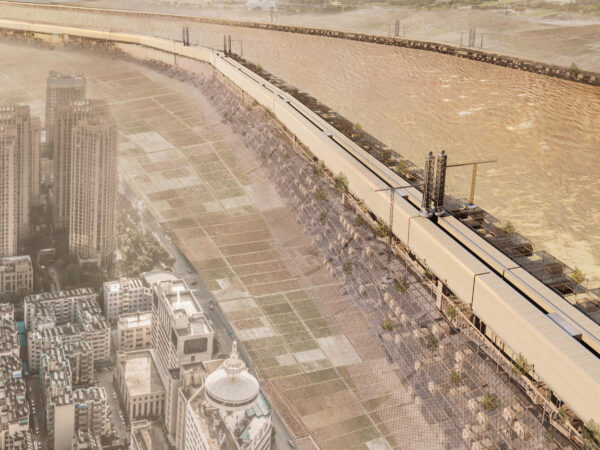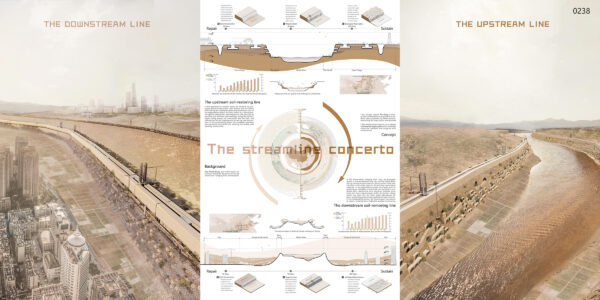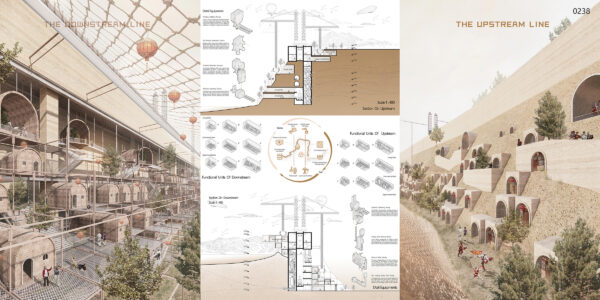2024 Skyscraper Competition
Second Place
Jianwei Zhu , Haoyu Liu, Yi Liu, Yanchu Liang
China
The streamline concerto
The Yellow River, revered as the Mother River of the Chinese nation, has shaped the banks along its course and the North China Plain, creating an ideal environment for agricultural revolution and laying a solid natural and geographical foundation for the emergence and development of Chinese civilization. However, as human history has progressed, the ancient ecology of the Yellow River has increasingly deteriorated. Sandstorms have become more severe near the Yellow River basin, and due to excessive cultivation and grazing upstream, soil erosion in the Loess Plateau has intensified. This has led to significant sediment accumulation and a continual rise of the riverbed downstream, resulting in the current situation of the elevated river, or ‘hanging river’, posing an imminent threat of riverbank breaches and urban flooding.
This design focuses on the environmental challenges of the Yellow River, addressing soil erosion upstream and the ‘hanging river’ phenomenon downstream. It adopts a philosophy of Yin-Yang harmony and collaborative management to comprehensively tackle these issues, aiming to achieve natural balance and soil-water improvement. We aspire that, in three 50-year cycles, through phases of restoration, regeneration, and sustainability, the architecture will blend into nature, and the sandstorms will be effectively controlled, soil in the upstream will no longer be lost, and the Loess Plateau will flourish; the riverbed downstream will be reduced to a safe level, turning the ‘hanging river’ into history. People will no longer fear the Yellow River’s breaches flooding cities, and the river will once again be the life-sustaining Mother River. We consider that skyscrapers may not develop vertically and could have a more diverse definition which means if necessary, skyscraper can extend in any certain direction. The twisty form of the Yellow River inspires us to design a skyscraper which develops along the riverbank and integrate with the natural environment, aiming to solve the ecological problem of the Loess Plateau.
The upstream earth-restoring line
In the upstream soil erosion areas, during the restoration phase, an ecological barrier is established between the Loess Plateau and the Yellow River to prevent further loss of loess. In the regeneration phase, the loess itself is used as a protective layer against sandstorms. Mechanical arms are employed to excavate and reinforce cave dwellings on both sides of the ecological barrier’s loess slopes. On the side closer to the Yellow River, living spaces for the population are constructed, while on the side closer to the Loess Plateau, laboratories for improving the quality of the loess soil are established. In the sustainability phase, the completed Upstream line will return to nature as fertile soil, evolving into habitable cave dwelling communities.
The downstream earth-removing line
In the downstream ‘hanging river’ area, during the restoration phase, an ecological barrier is initially erected between the city and the Yellow River to mitigate the risk of urban flooding during flood seasons. Subsequently, the silt from the hanging river is converted into raw material for 3D-printed building materials. During the regeneration phase, local waste materials like wheat straw, reeds, or plants like tamarisk and sagebrush are processed into protective films against sandstorms. Mechanical arms print modular units on both sides of the ecological barrier’s river embankments. On the side closer to the plain, living spaces for the population are constructed, while on the hanging river side, laboratories are established for improving the Yellow River’s water quality. In the sustainability phase, the completed Downstream line will return to nature as fertile soil, evolving into habitable modular community.

















